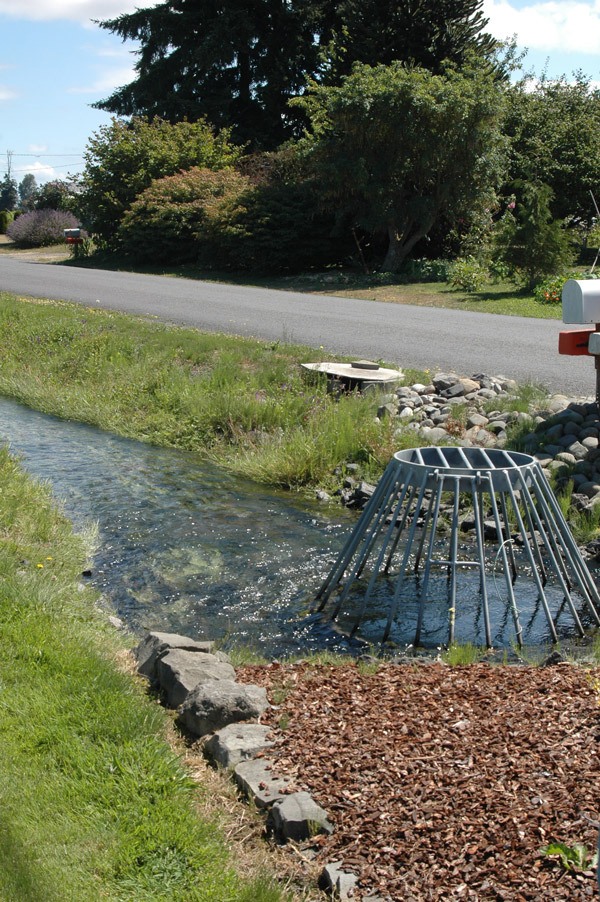The annual festival time, when the ditches are brimming, the queen is beaming, parade fans stake out their favorite curb, strongman competitors pump up and parade organizers pray for sun — successfully most years.
By the time this article is printed we’ll know who shimmied up the log pole fastest and whether sunburn was a problem or a distant fantasy …
All the while our farmers madly plow and plant — and water. It’s hard to imagine that the pioneers took time out at the start of their busy season to join the tractor parade, but they did. Apparently, celebrating water was pretty important. With their farms and small town growing and blossoming more each irrigation season, that’s understandable.
Another cause for celebration, no doubt, were the water rights various farmers acquired from the relatively new State of Washington, starting with Crazy Callen’s deliveries of water to customers of his Sequim Prairie Ditch Company in the late 1890s. According to the water doctrine of the West, established during the Gold Rush, first in time is first in right. The Dungeness River itself brimmed with snowmelt consistently every year, providing an obvious windfall for hardworking farmers who staked their claim.
Indeed, within a few decades there were about a dozen different private companies and public districts managing irrigation water diverted from the Dungeness River via five different headgates — three serving the east side and two going west.
A government map drawn in 1914 is laced with criss-crossing lines labeled “ditch,” “canal” or “lateral” throughout the Sequim Prairie and beyond. Ditchwalkers must have been very busy tending well over 100 miles of infrastructure and managing the flow. And where water was flowing, so, potentially, was wealth. Sounds like a good time to party!
Except during the Depression. Imagining this era of Sequim’s history is easier thanks to the popular book, “Boys in the Boat,” about Olympic rower Joe Rantz’s youth spent near Silberhorn Road. From Joe’s experience it is clear that a flowing irrigation ditch was sometimes an important source of household water, electricity and even food (before fish screens were built).
So what’s not to love? At some point, water managers and fisheries managers realized that the state had unwittingly granted the irrigators the legal right to divert more water from the Dungeness River than the river had to offer in late summer. Snowmelt season was consistent, but ended in July or August. Water right certificates indicated that irrigation season is April 15 to Sept. 15, with no requirement to lower the amount taken when the River dropped.
In addition, the prevalence of irrigation ditches and use of flood irrigation raised the water table under the prairie each summer. In many areas it was so shallow that new springs formed the headwaters of Hurd, Cassalery and Gierin Creeks. Settlers were able to drill a productive well by going only 20-40 feet down. More cause for celebration!
Except, as the century progressed, it was determined that water management methods didn’t pass legal muster. While the irrigators’ water rights are very strong, and senior, their stated purpose is to benefit agriculture, not the regional water table.
The situation with late summer low flows and legal issues was unsustainable and by the 1980s irrigation conservation was the new paradigm. Ditch managers focused on preventing ditch leakage and farmers began using more efficient ways to water. They wanted to avoid violating their rights, but they also realized that dewatering the Dungeness every August wasn’t a desirable way to do business.
With the turn of the millennium and maturity of scientific understanding, it is tempting to think that water management has evolved along with the comprehensive, complicated needs of society. In some very practical ways, such as local irrigation managers’ willingness to negotiate their senior rights to benefit the environment and a growing human population, the evolution is real. Another example is letting water into existing, leaky irrigation ditches to recharge and benefit the water table — this time with legal water rights.
In terms of water law, evolution is painfully slow.
But celebrating water always will be a favorite ritual in Sequim.
Note: Sequim Public Works is interested scanning historical maps of the area for our archives, especially maps showing irrigation ditches. Please contact me if you have something you can share!
Geek Moment
Current snow depth at the Dungeness SNOTEL site = 0 inches (and what’s left at higher elevations is melting faster than normal)
Snow-water-equivalent = 0 inches (since late March, a few weeks early)
(Dungeness SNOTEL site, elev. 4,010 ft.)
Cumulative rainfall in Sequim for the water year (starting Oct. 1) = 17.8 inches (above average)
(Sequim Water Reclamation Facility, elev. 45 ft.)
Ann Soule is a licensed hydrogeologist working on water quality and quantity concerns in the Dungeness watershed since 1990. She now works for the City of Sequim. Reach her at columnists@sequimgazette.com.



